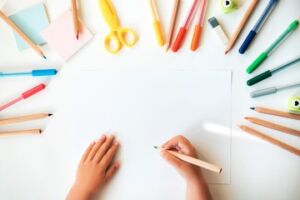Steps to draw Human Portraits
Step 1 – Papers and References
Selected a good plain sheet of sketching paper. Placed the smoother side of the sheet over a plane. Choose the best reference picture with good shades and lighting. Took a printout of the reference picture in an A4 sheet by scaling it to the size planned. Grid the reference picture with a 2H pencil to avoid darker impressions, at the dimension of a 1-inch scale as shown.
Step 2 – Outline
Used the grid lines to fix the position of each element of the portrait falling into the perfect size while sketching the outline. Made the outline of the portrait with an HB pencil, which was lighter and could be erased and corrected at any point in time. Once the outline was finished, I took up detailing using the shades of 2B and 4B pencils. To have a good start with the detailing, as a practice, always begin with the eyes as they are the most important factor and an element of a portrait.
Step 3 – Eyes
Used ‘Paper stumps’ or ‘Paper Tortillions’ to smudge the darker parts of the eyes as the character in the portrait had used darker eye cosmetics. The reflections of the eyes are very important as they make the eyes look real. Sketched the eyelashes individually and smudged it using the stumps. Made the shades below the eyes subtle so that the pencil strokes would not be visible. Took up the eyebrows and made them sharp at the edges as per the reference. It’s advisable to use a dusting bristle brush to wipe off all the pencil powders around the portrait in order to produce a quality output without messing it up.
Step 4 – Nose
Used the stumps instead of the darker pencil strokes to detail the nose. It was the only projected part of a portrait and the shades should have been very subtle so avoided darker lines.
Cheeks, Lips, and Skin
For this particular portrait, there were several shades required to create the cheeks, like in the reference picture. The character in the reference had a smile. To get the skin texture, use the ‘tissue papers’ for smudging the pencils strokes made over the side portions of the face. Gently rubbed the sketching sheet with the tissue paper so that the strokes smudged and smoother shades appeared.
Step 5 – Hair
Hair was the trickiest part of this portrait. The reference picture showed how darker and the deeper the shades of the hair were. Every hair had to be shown in detail to make it look realistic. At the beginning, strokes had to be made with the flow of the hair from the root of it because only by this an illusion of creating the hair with perfect shades could be attained. Made sure not to shade at the parts where it had to shine or glow.
Step 6 – Detailing
The final objects of the portrait would be the neck and the dress. The texture of the dress used in the reference picture varied due to the lighting. So used different pencils to show the difference in the shades. Strokes should not be visible as they would make the portrait look messy. Smudged the strokes until the textured cloth was created. Kept it gentle as there were chances of damaging the sheet due to over smudging.
Step 7 – Finalising
Used the ‘kneaded eraser’ to show the highlighted regions of the portrait. There was a small reflection of the lighting near the right cheeks. Use the kneaded eraser gently to wipe out the shades and make it look like a glow. Took off all the grid lines from the sheet as the last step. Erased all the unwanted shades around the portrait. Arrived at the final image.





